Multi-Domain Computing Research: A Summary of Several Ideas and Product Strategies for Cross-Domain Integration
1. Several ideas and strategies for cross-domain integration of OEMs
With the increasingly stringent requirements for advanced autonomous driving in terms of computing power, communication bandwidth, software, and security,? automotive electronic and electrical architecture? (EEA) has gradually evolved from a domain-centralized architecture to a multi-domain integration, and then to a central computing architecture. At present, the main integration ideas for automotive multi-domain computing are as follows:
The central control domain integrates body, chassis, power, gateway, etc.;
Digital chassis integrates intelligent driving, cockpit, etc.;
Cockpit-driving integration computing platform;
Quasi-central computing platform (One Box, multi-board, multi-core);
Central computing platform (One Box, mostly single board, equipped with single or multiple high-performance chips, using board-level interconnection technology).
At present, Leapmotor and Voyah have evolved into a central computing platform, Xpeng has entered a quasi-central computing platform, and most players have also entered the stage of domain integration, among which the development of cockpit-driving integration computing platform is relatively booming.
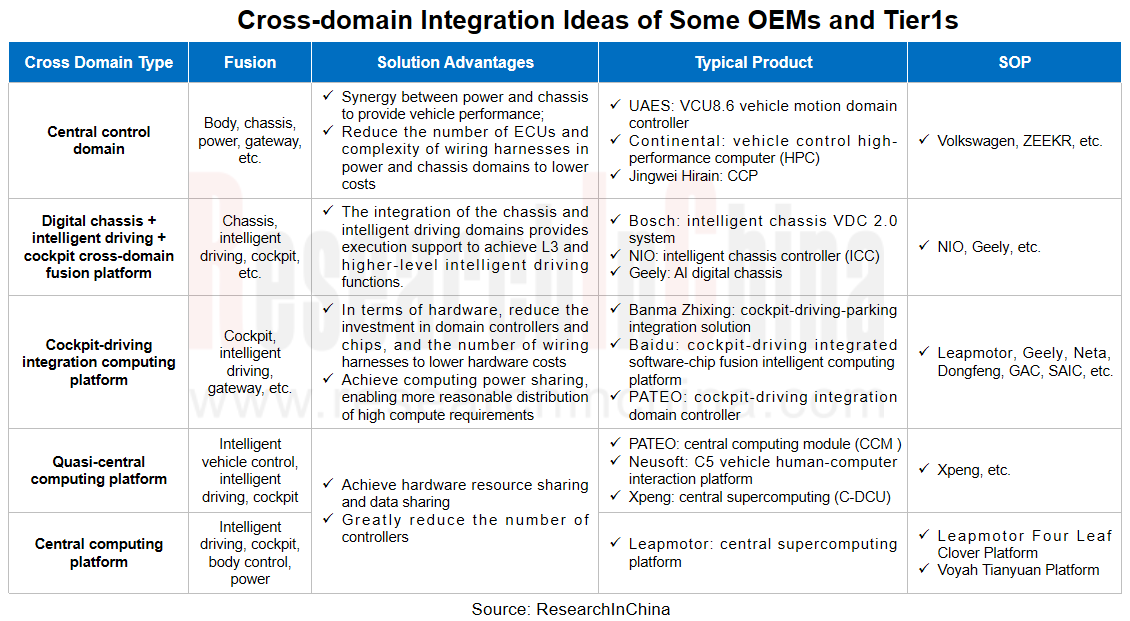
With the development of autonomous driving, cross-domain integration is imperative, and OEMs are accelerating the implementation of cross-domain integration models.
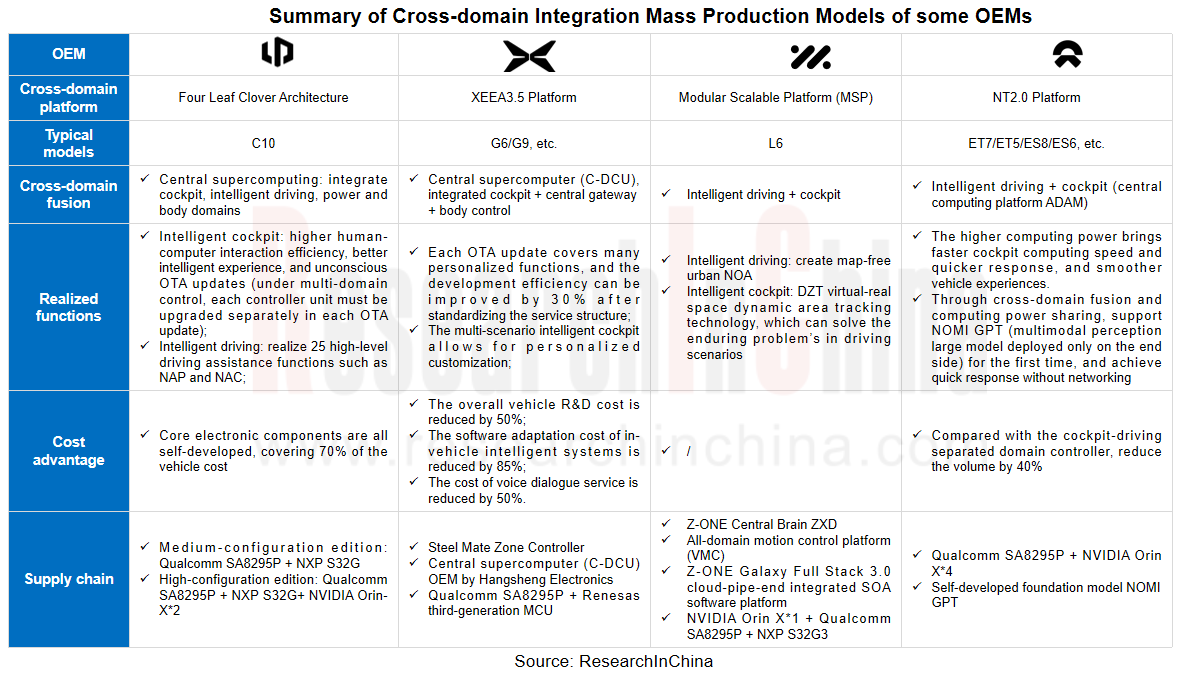
NIO central computing platform ADAM
The ADAM cross-domain solution of NIO's central computing platform integrates two chips on the same circuit board. The central computing platform ADAM can eliminate the need for encoding and decoding between different domains in the car, eliminating the need for encoding and decoding chips, power supplies, heat dissipation, wiring harnesses, etc. It directly replaces Gigabit Ethernet through etching circuits on the circuit board, and the cross-domain data bandwidth between intelligent driving and cockpit is greatly increased from Gigabit to 16Gbps, achieving a transmission rate increase of more than 10 times.
In addition, through cross-domain computing power sharing, each large computing power demand can be more rationally allocated, allowing intelligent driving chip NVIDIA Orin X and intelligent cockpit chip 8295 to solve their respective tasks.
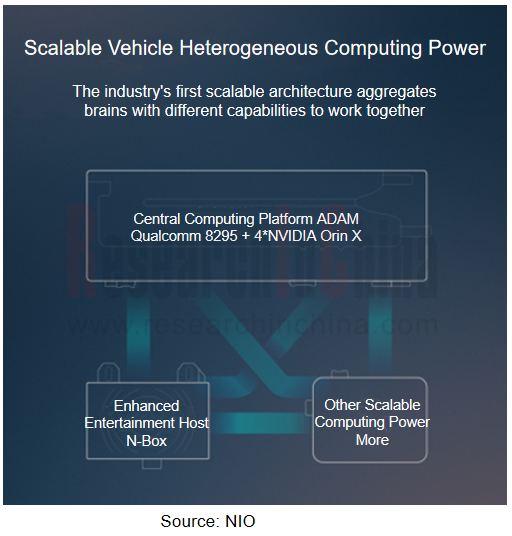
Neta Haozhi Supercomputer XPC-S32G
In June 2024, Neta, NXP, HiRain, and Wind River jointly released the first integrated gateway domain control product--Haozhi Supercomputer XPC-S32G, which will be launched in 2024H2 with the new Neta S model.
Haozhi supercomputer XPC-S32G is based on the growing EEI architecture of Neta Shanhai Platform:
Equipped with NXP's high-performance S32G3 automotive network processor based on Arm Cortex-M7 and Cortex-A53;
Equipped with Wind River's advanced RT-Linux operating system solution;
Equipped with a SOA software architecture based on a powerful integrated development environment.
Neta plans to use Haozhi Supercomputer XPC-S32G as the basis for the vehicle network backbone system and service-oriented SOA architecture. The system can be understood as the "hub" of in-vehicle communication backbone network, with nine functions of central gateway, vehicle thermal management, battery energy management, power torque management, remote diagnosis, calibration, full data collection, SOA-type service gateway, edge computing and OTA Master, which can realize the interconnection of high-security cross-domain functional data, as well as automotive cyber security defense, and is responsible for vehicle control management, ensuring information output with extremely low delay, and has future-oriented vehicle function iteration capabilities.
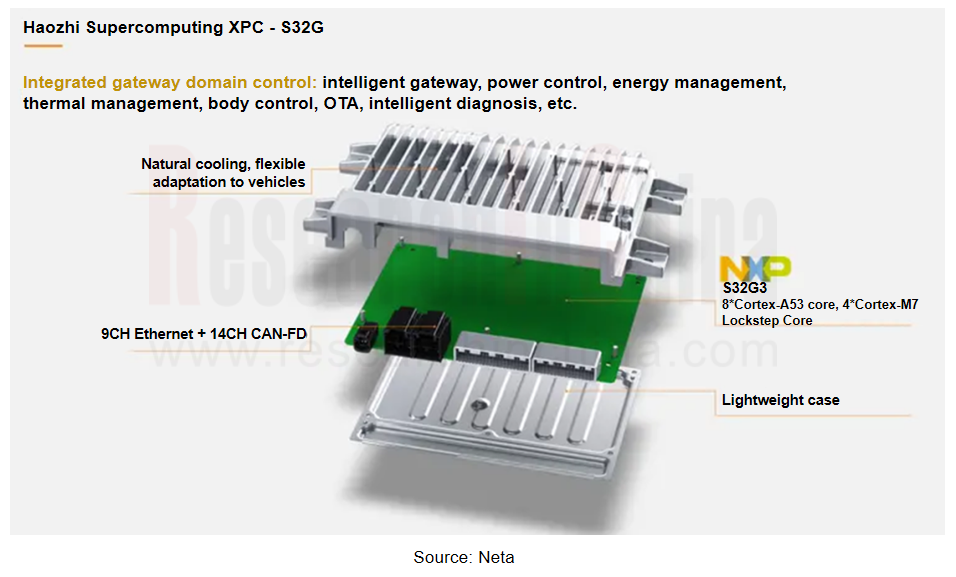
2. Cross-domain integration products of Tier1 suppliers: from cockpit-driving integration platform, central cross-domain platform, quasi-central computing platform, central computing platform and other dimensions
Product development direction (1): cockpit-driving domain + functional domain (gateway, network connection, body, chassis, etc.) integration
Since 2024, OEMs have successively implemented the cross-domain integration architecture and gradually iterated to the central computing platform. In the process of cross-domain integration, "cockpit-driving integration" and "cockpit-driving + other domains" concentrate the computing power of the whole vehicle, closer to the central computing platform, and are currently one of the mainstream directions of cross-domain integration. Judging from the current supply layout, most of the solutions for cockpit + cockpit-driving integration are done.
In order to meet the mainstream development trend, Tier1s has also increased its cross-domain Product R&D, such as ECarx, JoyNext, AutoLink, PATEO, Continental, Desay SV and other suppliers, have launched relevant cross-domain integration solutions.
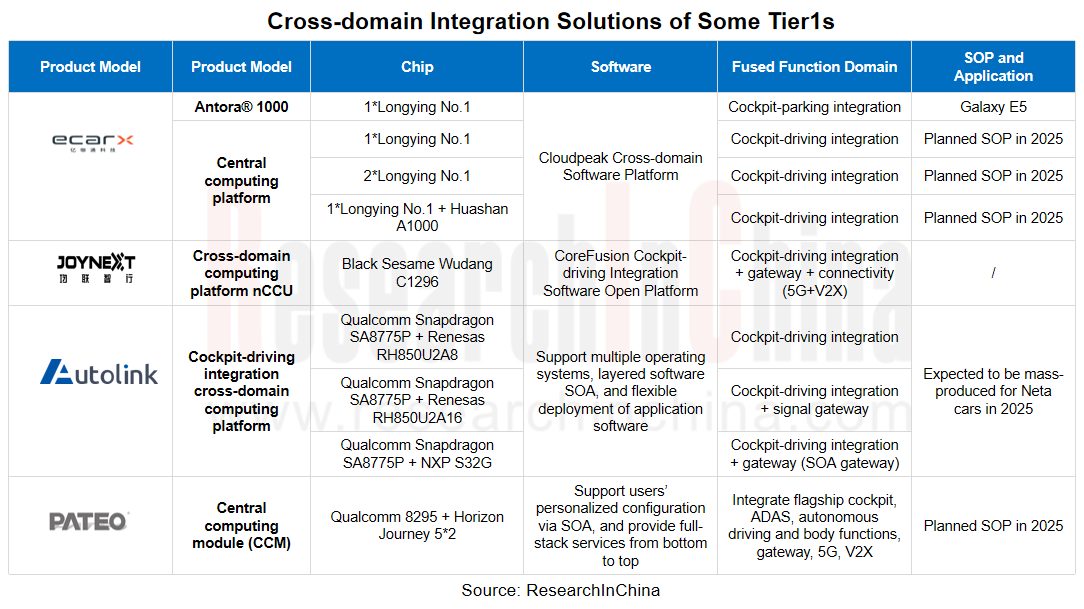
ECarx's cross-domain integration solutions are divided into two types: "cockpit-parking" and "cockpit-driving". The single-chip "cockpit-parking integration" solution based on "Longying No. 1" chip has been installed in mass production model of Galaxy E5, realizing the integration of intelligent cockpit and automatic parking functions.
The cockpit-driving integration solution is planned for mass production on the model in 2025 and is divided into two series:
One is a cost-effective solution for basic "cockpit-driving-parking" functions, such as "Car Brain ? Antola Series", which adopts cockpit SoC Longying No. 1 with strong AI computing power. On the basis of original cockpit capability, an additional 2MP binocular camera can support development of "cockpit-driving-parking" functions, including HWA (highway assistance), ALC (automatic lane change assistance), APA (automatic parking assistance), RPA (remote control parking), as well as DMS (driver monitoring system), full scene voice interaction, HMI (human-machine interface) and other functions.
The second is a high-performance solution for high-order "cockpit-driving-parking" functions, such as "Car Brain Series". Through the single-board integration of two high-performance SoCs of intelligent cockpit + intelligent driving, cockpit-driving is realized. Through Ecarx Yunshan cross-domain software platform, the computing power can be reasonably allocated to each demand module. PCIe high-speed data transmission is used, and the transmission efficiency is more than 10 times higher than that of the traditional. With the high computing power of the two SoCs, it supports high-order autonomous driving functions of L2 + and above to match the demand of the mainstream market for high-order autonomous driving. At the same time, the scalable design of the overall architecture also provides better flexibility for the future chip computing power allocation. The integrated software and hardware greatly improve development efficiency? and significantly reduce BOM cost of the solution.
Product development direction (2): body electronics extend to central control, integrating digital chassis, power, new energy systems, etc
Traditional body electronics are gradually developing cross-domain central controller products, which are further integrated with chassis, power, and new energy systems.
Taking UAES as an example, in order to meet the hardware and software needs of customers in the new EEA? of future automobiles, UAES established Cross-Domain Control Business Unit (Advanced Connection Business Unit) in April 2021, which was integrated from the former Electronic Controller Business Unit and the Body Electronics Business Unit. Beginning in 2024, the organizational structure will be further integrated, and all low-voltage controller businesses will also be merged into the Cross-Domain Control Business Unit.
The Cross-Domain Control Business Unit launched hardware products such as in-vehicle computing platform (VCP), zonal controller (ZECU), body domain controller and smart grid management module (PNG), as well as service-based software architecture (SOA) and USP software development platform.
In 2023, UAES has acquired and synchronized the development of? "central computing + zonal controller + SOA" platform on the new architecture for 8 customers, and realized the mass production of the first zonal controller product in Chinese market in June 2023. Through zonal architecture, nearly 20 independent ECUs can be integrated, and the communication rate can be increased from 2M to up to 1000M.
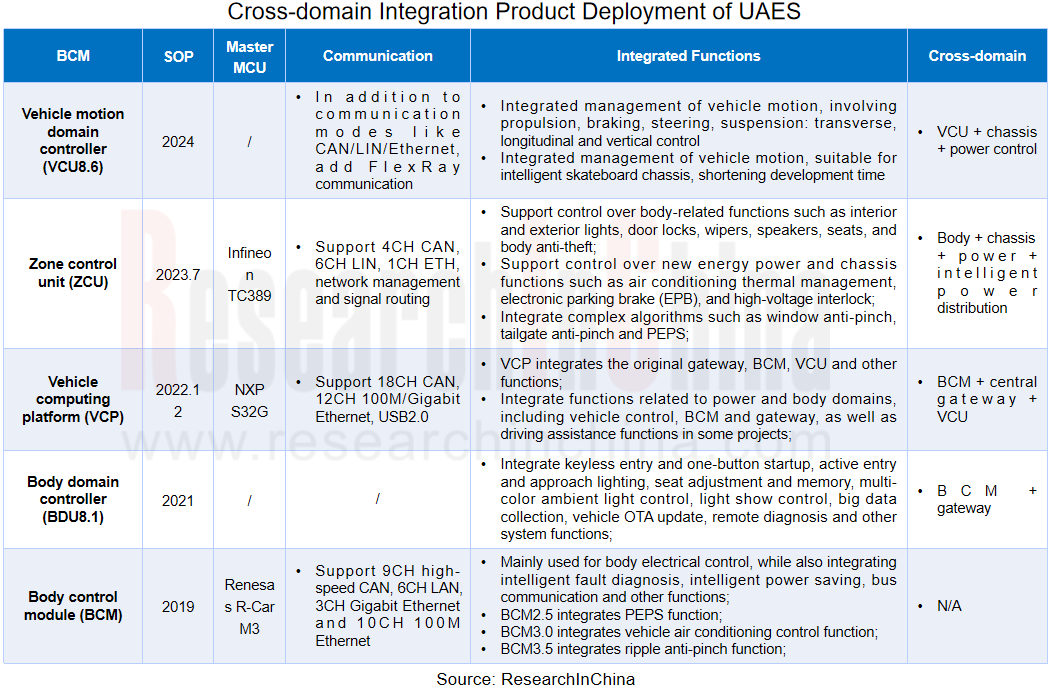
3. Cross-domain integration software platform: a foundation for enabling cross-domain computing
Single-chip fusion deployment of multiple function sets will make software complexity increase significantly, which brings new concerns for OEMs, but also an urgent need to solve the problem,ECARX, NESINEXT, ThunderSoft, ArcherMind?Technology and others have launched relevant cross-domain software solutions.
ECARX Cloudpeak Cross-Domain Software Platform
In response to the development trend of cross-domain integration, central computing, and the actual mass production needs of global delivery, ECARX has launched ECARX Cloudpeak cross-domain software platform for the global smart car market, which is designed with SOA concept to ensure standardization and modularization of components, covering the underlying system software (Cloudpeak Virtualization), multi-operating systems, middleware, upper-layer application modules, and global application ecosystems. It can be combined with its different computing platforms to form a complete solution, easily realizing cross-domain functionality. It has been deployed on multiple mass-produced models.
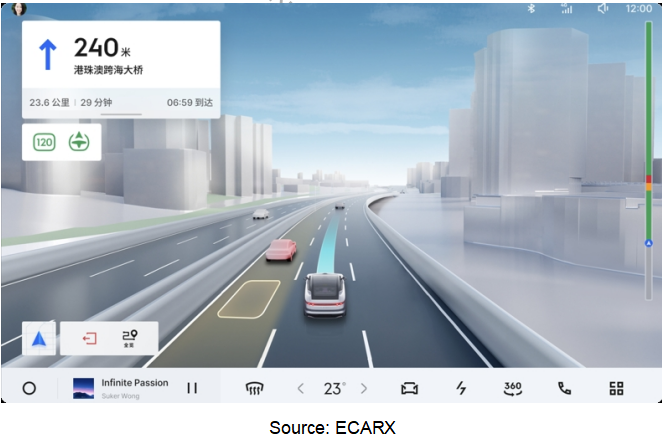
In the Lynk & Co Z10 smart cockpit solution to be released, thanks to ECARX Cloupeak's interconnection of cockpit and intelligent driving systems, the image information sensed by sensors associated with? intelligent driving is processed and presented on the central control screen in real time. At the same time, it integrates the lane-level navigation of cockpit domain and NOA function of? intelligent driving domain, perfectly presenting a "human-computer co-driving" interface, realizing an immersive interactive experience that restores the real physical world.
NESINEXT CoreFusion cockpit-driving integration software open API
NESINEXT and Black Sesame Intelligent jointly create the open API of cockpit-driving integrated software, which is developed based on Wudang C1296 chip, which can solve the difficulties and pain points of single SoC cross-domain fusion function deployment, and can provide OEMs and ecological partners with full-stack, efficient, and low-cost development of operating system-level software bases, power builder chains, and ecosystems.
JoyNext has a mature tool chain, creating an intelligent cockpit framework, intelligent driving AP/CP middleware and automation adaptation tools that can support C1200 series chip platform. JoyNext and Black Sesame Intelligence have cooperated for many years, and have carried out in-depth cooperation in the fields of cockpit-driving integration operating system-level software base, power builder chain and complete ecosystem.
Under the trend of central computing architecture, the in-vehicle operating system has begun to evolve from a domain operating system to a vehicle operating system. By integrating the functions of cockpit operating system, intelligent driving operating system, and safety vehicle control operating system through central computing platform, the development efficiency of OEMs can be improved.
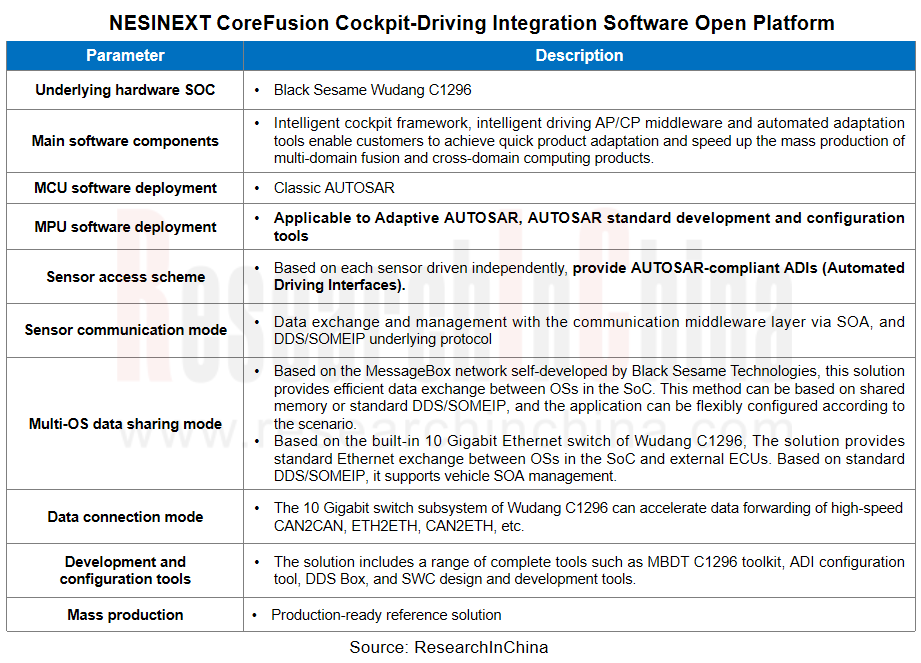
NIO global operating system Tianshu SkyOS
NIO intelligent electric vehicle global operating system Tianshu SkyOS is the underlying operating system of NIO vehicle, establishing a comprehensive and three-dimensional technical system for vehicle R&D, so that various devices can be organically integrated to achieve efficient collaboration.
SkyOS has built a "1 + 4 + N" technology cluster, covering multiple fields such as vehicle control, intelligent driving, cockpit, mobile Internet, etc., and has become a comprehensive and leading intelligent digital technology base. The NIO full stack has developed four sub-core systems, including "SkyOS-M", "SkyOS-L", "SkyOS-R" and "SkyOS-C".
SkyOS-L: The first domestic alternative to AutoSAR and a large-scale commercial real-time operating system. In comparison with AUTOSAR, SkyOS-L can execute stably whether it is a high-priority, medium-priority or low-priority instruction. AUTOSAR is not as accurate as SkyOS-L in medium-priority and low-priority instructions.
SkyOS-M: It is a micro-kernel architecture, running in the central brain, mainly controlling the body, chassis, suspension, etc. The kernel is more stable than the traditional Linux, and the service isolation is better. At the same time, on the basis of security isolation, there are four layers of monitoring and three layers of recovery security mechanism.
SkyOS-C: A deeply customized operating system based on Android, carrying the functions of a smart cockpit, self-developed TOX protocol stack, more stable data transmission, and AI intelligent experience including NOMI.
SkyOS-R: Increase the load capacity of the system.
Intelligent Vehicle Multi-Domain Computing Industry Report, 2024 mainly studies following:
 Typical multi-domain computing architecture ideas, including Tier 1's cross-domain computing product layout and ideas, OEMs' cross-domain product layout and ideas, etc.
Typical multi-domain computing architecture ideas, including Tier 1's cross-domain computing product layout and ideas, OEMs' cross-domain product layout and ideas, etc.
 Multi-domain computing platform, including central control domain, digital chassis +intelligent driving + cockpit integration domain, cockpit-driving integration domain, quasi-central computing platform, central computing platform and other products;
Multi-domain computing platform, including central control domain, digital chassis +intelligent driving + cockpit integration domain, cockpit-driving integration domain, quasi-central computing platform, central computing platform and other products;
 Research on the impact of multi-domain computing on automotive software,? MCU, VCU, and ECU;
Research on the impact of multi-domain computing on automotive software,? MCU, VCU, and ECU;
 Research on the layout, mass production, and cooperation of OEMs in multi-domain computing;
Research on the layout, mass production, and cooperation of OEMs in multi-domain computing;
 Research on the development, the latest technology layout, and product dynamics of Tier1s in multi-domain computing at home and abroad.
Research on the development, the latest technology layout, and product dynamics of Tier1s in multi-domain computing at home and abroad.